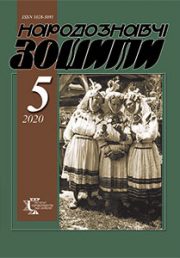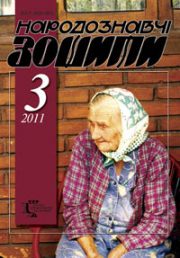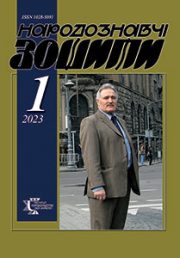The Ethnology Notebooks. 2021. № 5 (161), 1218—1233
UDK 27-523.47-526.62(477.86-21)”16/17″
DOI https://doi.org/10.15407/nz2021.05.1218
KOSIV Roksolana
- ORCID ID: http://orcid.org/0000-0002-1202-1488
- Doctor in Art Studies,
- Associate professor, Lviv National Academy of Arts,
- Senior scholar, National Museum in Lviv named afterAndrey Sheptytsky
- 38, Kubiiovycha Street, 79011, Lviv, Ukraine
- Contacts: e-mail: lanakosiv@yahoo.com
Abstract. Problem statement. In the collection of the National Museum in Lviv named after Andrey Sheptytsky (further — NML) there is a group of the 17th — early 18th century icons from the churches in Voinyliv, Yezupil, Rohatyn and Dolyna in Ivano-Frankivsk region, which presents the direction of development of church art in this area. More detailed study of these icons allow us to compare them with stylistically similar works and highlight aspects of the development of local icon painting.
The purpose of the article is to systematize the icons from the Dolyna churches in the manner of painting, to correlate the descriptions of icons from the documents of 18th century church visits with specific works to be able to reconstruct the original location of some and call attention to works painted by one master, belonging to the same iconostasis.
The methods of formal and iconographic analysis, and the method of reconstruction are used. The icons are analyzed with the consideration of the cultural context.
Conclusions. The 17th — early 18th century icons from the Dolyna churches in the collection of the NML show similar tendencies as the group of previously researched icons of the first half of the 17th century from the churches in Voinyliv (NML). A group of mid-17th century icons that we associate with the Archangel Michael church in Dolyna — three Sovereign tier icons have a common manner of painting with two icons from Bolokhiv in Ivano-Frankivsk region, in terms of the overall composition of the frames — with icons in the Sovereign tier of the iconostasis in the Holy Spirit church in Rohatyn (1650), and the stylistic of painting is similar with the Sovereign tier icons of two Holy Paraskeva in the iconostasis of St. Paraskeva church in Lviv (1640-ies). These icons, as well as festive icons from Dolyna, show the influence of icon painting of the Lviv school. Two icons associated with the Church of the Nativity of the Virgin Mary in Dolyna — the icon of the Virgin Hodegetria with the praise and Passion of Christ icon (1630—1640-ies) have similar manner of interpretation of figures so, we assume, they are painted by one master. The Descent of the Holy Spirit icon (early 18th century) from Dolyna shows a connection with the works of the authors of the Bohorodchany (Skyt Manyavskyi iconostasis), actually the workshop of Yov Kondzelevych, which apparently influenced the development of local iconpainting.
Keywords: icon, iconostasis, icon painting center, church art, church, Dolyna town, documents of the 18th century church visits.
Received 10.09.2021
REFERENCES
- Melnyk, V. (1991). Church of the Holy Spirit in Rohatyn. Album. Kyiv [in Ukrainian].
- Aleksandrovych, V. (2013). Masters of «small» centers of Ukrainian painting of the historical Peremyshl-Lviv region of the first half of the 17th century. Society. Almanac of Social History (Issue 10, pp. 9—30). Kyiv [in Ukrainian].
- Drahan, M. (1970). Ukrainian decorative carving of the XVI—XVIII centuries. Kyiv [in Ukrainian].
- Zilinko, R. (2013).Deacon’s door with the Archangel Michael and Melchizedek of the middle of the XVII century. Sights of Ukraine: history and culture, 12, 54—59) [in Ukrainian].
- Kosiv, R. (2020). Icons of the 17th — first half of the 18th century from Voinyliv churches in Ivano-Frankivsk region in the context of church visits descriptions, reconstruction of location, and attribution. The Ethnology Notebooks, 5, 1081—1096 [in Ukrainian].
- Sventsitskyi, I. (1928). Iconpainting of Galician Ukraine of the XV—XVI centuries. Lviv [in Ukrainian].
- Sventsitskyi-Sviatitskyi, I. (1929). Icons of Galician Ukraine of the XV—XVI centuries. Lviv [in Ukrainian].
- Sydor, O. (2000). Icons of masters Oleksiy and Dmytriy in the collection of the National Museum in Lviv. Chronicle of the National Museum in Lviv (Pp. 89—152). Lviv [in Ukrainian].
- Berezhnaya, L., & Himka, J.-P. (2014). The World to Come: Ukrainian Images of the Last Judgment. Cambridge, MA: Harvard University Press.
- Patriarch Dymytrii (Yarema). (2017). Western Ukrainian icon painting of the 16th — the beginning of the 17th centuries. Lviv [in Ukrainian].
- Helytovych, M. (2008). Icons from the Dolyna are valuable monuments of Ukrainian art. Archaeological trails of the Dolyna. Collection of scientific and theoretical articles, 2, 47—56 [in Ukrainian].
- Matviyiv, I. (2008). Research and study of archeological and sacred pages of the Dolyna, problems and possibilities of their solution. Archaeological trails of the Dolyna. Collection of scientific and theoretical articles, 2, 83—95 [in Ukrainian].
- Fedak, M. (2020). A group of icons from the end of the 16th — beginning of the 17th century from Dolyna «circles of the master of the iconostasis from St. Michael’s Church in Dolyna». Bulletin of the Kharkiv State Academy of Design and Arts, 1, 62—70 [in Ukrainian].
- Sventsitska, V., & Sydor, O. (1990). Heritage of the ages. Ukrainian painting of the 14th— 18th centuries in the Lviv museum collections. Lviv [in Ukrainian].
- Pavlychko, Ya. (2005). Two icons of the «Intercession of the Virgin» of the of the XVII and the end of the XVII — beginningof the XVIII century from the churches of Dolyna in Ivano-Frankivsk region. Volyn icon: research and restoration (Pp. 47—48). Lutsk [in Ukrainian].
- Gronek, A. (2007). Icons of the Passion. On the changes in the church painting of the Ukrainian-Polish borderland. Cracow [in Polish].
- Kostowiecka, J. (1936). From the early days of the Dolina. Dolina [in Polish].
- Matskevyi, L. (2008). The most ancient past of Dolyna district of Ivano-Frankivsk region. Archaeological trails of the Dolyna. Collection of scientific and theoretical articles, 2, 24—32 [in Ukrainian].
- General visit of the Lviv diocese in 1740 and 1743. (1743). National Museum in Lviv named after Andrey Sheptytskyi. Department of Manuscripts and old printed books (Ркл-17) [in Polish and Latin].
- General visit of the Lviv diocese in 1761—1762. (1762). National Museum in Lviv named after Andrey Sheptytsky. Department of Manuscripts and old printed books (Ркл-22) [in Polish and Latin].
- Sventsitska, V., & Otkovych, V. (Eds.).(1991). Ukrainian folk painting of the XIII—XX centuries: the world through the eyes of folk artists: album. Kyiv [in Ukrainian].
- Helytovych, M. (2005). Theotokos with Child and with praise. Ikons from the collection of the National museum in Lviv named after Andrey Sheptytsky. Lviv [in Ukrainian].
- Helytovych, M. (2003). Ukrainian icons of the Savior in Glory. Lviv [in Ukrainian].
- Helytovych, M. (2019).Three folk painters of the late XVI — early XVII centuries. Art studies, 2, 23—37 [in Ukrainian].
- Sydor, O. (2012). Patriarch Yosyf Slipy and the art. Lviv; Rome [in Ukrainian].
- Milyaeva, L. with the participation of Helytovych, M. (2007). Ukrainian icon of the XI—XVIII centuries: album. Kyiv [in Ukrainian].
- Horda-Tsybko, O. (2013). «Apostle Andrew with the life scenes» by Mykola Morokhovsky Petrakhnovych). Sights of Ukraine: history and culture, 12, 60—67 [in Ukrainian].
- Zheplynska, O. (2001). Epitaphportrait of Olexander Svystelnytsky in the collection of the National Museum in Lviv. Chronicle of the National Museum in Lviv (Pp. 103—107). Lviv [in Ukrainian].
- Belikova, H., & Chlenova, L. (Eds.). (2005). Ukrainian portrait of the XVI—XVIII centuries. Catalog-album. Kyiv [in Ukrainian].






